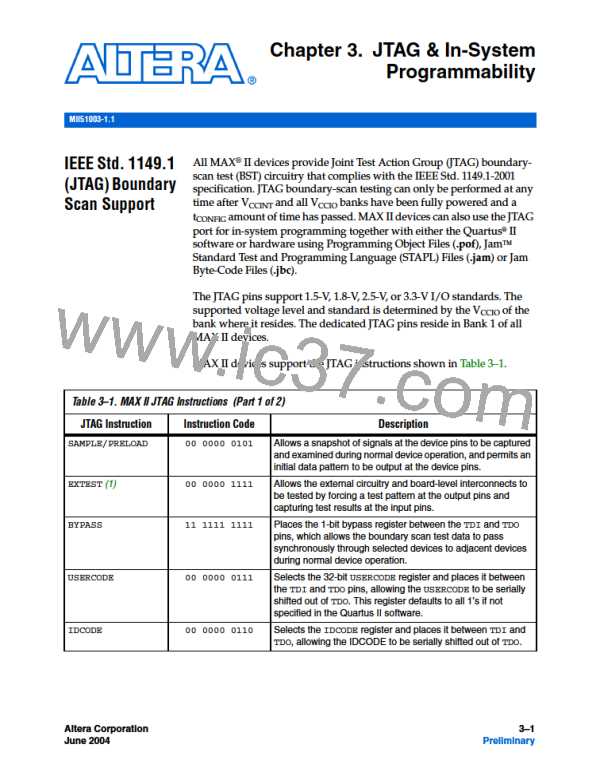JTAG & In-System Programmability
debugging cycles. The logic, circuitry, and interconnects in the MAX II
architecture are configured with flash-based SRAM configuration
elements. These SRAM elements require configuration data to be loaded
each time the device is powered. The process of loading the SRAM data
is called configuration. The on-chip configuration flash memory (CFM)
block stores the SRAM element’s configuration data. The CFM block
stores the design’s configuration pattern in a reprogrammable flash array.
During ISP, the MAX II JTAG and ISP circuitry programs the design
pattern into the CFM block’s non-volatile flash array.
The MAX II JTAG and ISP controller internally generate the high
programming voltages required to program the CFM cells, allowing in-
system programming with any of the recommended operating external
voltage supplies (i.e., 3.3 V/2.5 V or 1.8 V for the MAX II devices with a
“G” ordering code). ISP can be performed anytime after VCCINT and all
VCCIO banks have been fully powered and the device has completed the
configuration power-up time. By default, during in-system
programming, the I/O pins are tri-stated and weakly pulled-up to VCCIO
to eliminate board conflicts. The pull-up value ranges from 5 to 40 kΩ.
There are two other options in MAX II devices that allow user control of
I/O state or behavior during ISP.
f
For more information, refer to “In-System Programming Clamp” on
page 3–8 and “Real-Time ISP” on page 3–8.
These devices also offer an ISP_DONEbit that provides safe operation
when in-system programming is interrupted. This ISP_DONEbit, which
is the last bit programmed, prevents all I/O pins from driving until the
bit is programmed.
IEEE 1532 Support
The JTAG circuitry and ISP instruction set in MAX II devices is compliant
to the IEEE 1532-2002 programming specification. This provides
industry-standard hardware and software for in-system programming
among multiple vendor programmable logic devices (PLDs) in a JTAG
chain.
The MAX II 1532 BSDL files will be released on the Altera web site when
available.
Altera Corporation
June 2004
Core Version a.b.c variable
3–5
MAX II Device Handbook, Volume 1

 ALTERA [ ALTERA CORPORATION ]
ALTERA [ ALTERA CORPORATION ]